The Book Piles newsletter returns to review a memoir, a novel and a comic book about finding truth in crime
Thank you for coming to the pile. Let’s consider the psychological impact of closely scrutinized murder.
Books
I Know Who You Are | Barbara Rae-Venter | Ballantine Books | 2023
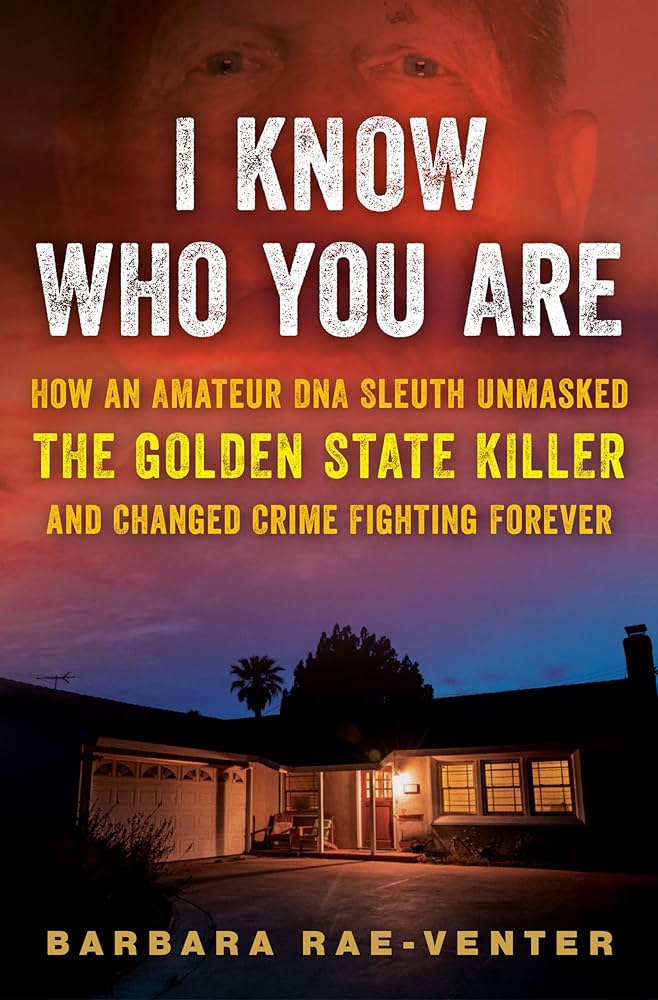
Barbara Rae-Venter’s 2022 non-fiction memoir details a forensic genealogist’s quest to catch serial killers. With DNA sample left at the scene, investigators can match it with samples collected from millions of people. This book shocked me in ways few things do.
What shocked me is the conclusive proof that our DNA is not private. Enough people took at-home DNA tests (like 23 and Me), and because of genetic similarity between relatives, gene databases contain 90% of people’s DNA.
The author used this research technique to find the Golden State Killer, Joseph James DeAngelo. The former police officer admitted guilt, and a judge convicted him after being presented with every possible piece of evidence a prosecution could bring against a person: eyewitness testimony, material evidence, and a well-established and analyzed timeline. A true crime writer, Michelle McNamara laid out a clear timeline in I’ll Be Gone In The Dark. Unfortunately, the author died, and her files were given to other investigators.
I Know Who You Are continues the story of the apprehension and prosecution of DeAngelo. Rae-Venter specifies how DNA evidence was used to find him and how police got confirmation samples by swabbing DeAngelo’s car door handle and stealing a used Kleenex. To vastly oversimplify it, an investigator uploads a DNA sequence to Ancestry.com and compares it with other sequences on the site. Rae-Venter built thousands of family trees from possible DNA matches and then researched the individuals on the associated tree.
When they narrowed the suspect profile, the author explained that her co-investigator (a retired detective) couldn’t believe a police officer would do this. They assumed it was someone in the real estate industry who had keys to many locks. It’s just another ominous association between police and real estate.
Of course, it was a police officer. Employed by police departments in both Exeter and Auburn, CA, DeAngelo was a burglary unit officer. He likely learned how to break into houses by investigating many cases where people did just that. In a witness testimony, she recalled DeAngelo cursing his ex-wife and blaming another man for “making him do this.” How weird that, in this case, the actual criminal happened to be the police officer 🙂
The book isn’t just about the Golden State Killer investigation. Rae-Venter explains how she got interested in forensic genealogy, her family history and search for genealogical truth, other non-criminal investigations like reuniting long lost family members, and even tips for aspiring investigative genealogists.
And she confronts the ethical questions head-on, although I disagree with her conclusions. What makes a crime “true”? Can truth be stripped down to the base building blocks of human genetic material? Does one’s right to privacy get trumped by our collective right not to get murdered and catch murderers? These are the questions at the heart of DNA evidence.
The practical concerns are immediately relevant to sexual assault cases. Police departments with DNA evidence now have a much more reliable means of finding these men. The author imagines a future where this could upend how current assault investigations.
Investigative genealogy also has a place in the future of unarmed police response. The author and her co-investigator on the GSK case were both retirees. They solved a cold case for really cheap! Forensic DNA investigations only require biosamples, access to DNA databases and laboratories, and investigator hours. These were unsalaried volunteers. Now imagine a world where this technology scales up to a speed that can solve cases without decades of inactivity.
Of course, corrupt police and prosecuting attorneys can manufacture DNA evidence. Since the American justice system has a quota of people to send people to private prisons, I predict genetic genealogy will convict people than it exonerates. The police could say they found a DNA sample at the scene when they didn’t. How could a defendant falsify the evidence without access to samples or technicians? These are just some horrifying questions to ruminate on throughout the future.
Rabbit Hole | Kate Brody | Soho Crime | 2024
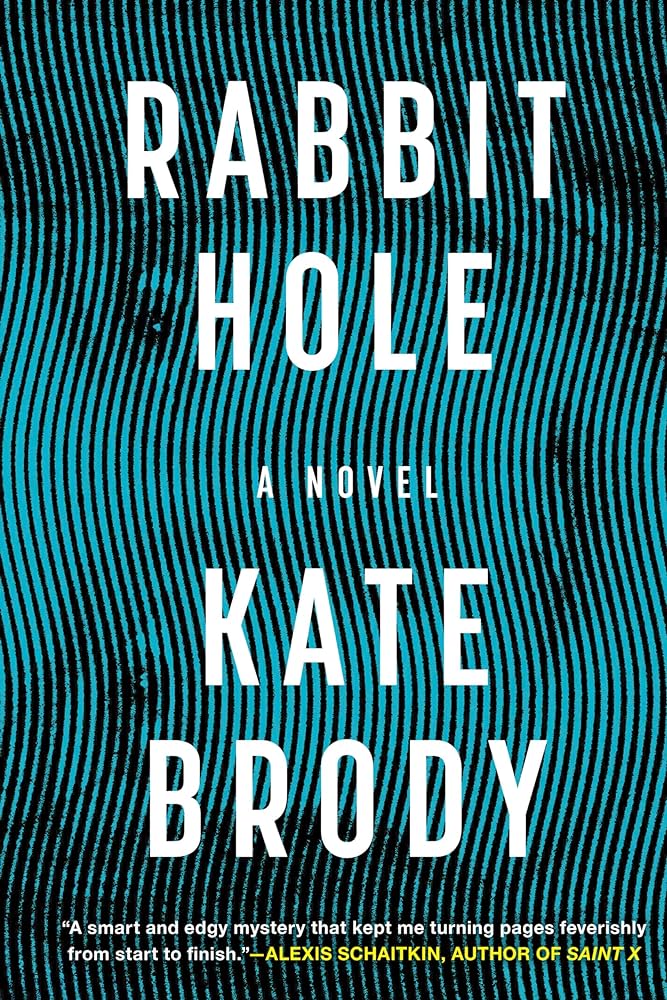
Rabbit Hole, Kate Brody’s debut novel, is a dramatized version of a true crime obsession gone awry. Teddy is a high-achieving English teacher and a woman on the edge. Her sister went missing about a decade ago, her family never dealt with the trauma, and the novel begins after her dad finally committed suicide after an obsessive investigation. Teddy seeks answers.
There are family secrets, a psychic, unprescribed pills, a cam girl, an estranged brother, an illegally purchased firearm, bawdy twists, shocking betrayals, and high-heat sex scenes. The calls come from inside the house, so it’s a domestic thriller but one set firmly in cyberspace. Our protagonist processes her trauma through experiences on the internet.
Reddit acts as a setting, a collection of deranged characters, and the book’s inciting incident. When Teddy pokes her toe in her father’s investigation, Reddit doxxes her, sending her to the titular rabbit hole. Brody fictionalizes Reddit threads and recreates the schizophrenic thrill of a Reddit investigation—look at all these connections and implications! There’s always a Reddit comment to drive somebody just a little bit crazier.
What’s gained from Reddit investigations? Those who dislike ambiguous endings should brace themselves because there are no easy answers or clear conclusions. Does Rabbit Hole make readers reconsider who’s on the True Crime message boards? Sure, there’s a bunch of obsessive freaks (take me, for example), but these traumas also impact the family members. The message boards call themselves “communities,” a misleading name for anonymous people data-mining a dead person’s most vulnerable personal information. These message boards even entice participation from a victim’s loved ones.
There’s the idea that, eventually, the investigation will crack, and the victims will get justice. And
I Know Who You Are offers an example, but I think Rabbit Hole provides a more emotionally truthful outcome to becoming an online vigilante. It hurts one’s spirit.
Comics
Where The Body Was | Ed Brubaker (Writer) | Sean Phillips (Illustrator) | Image | 2024
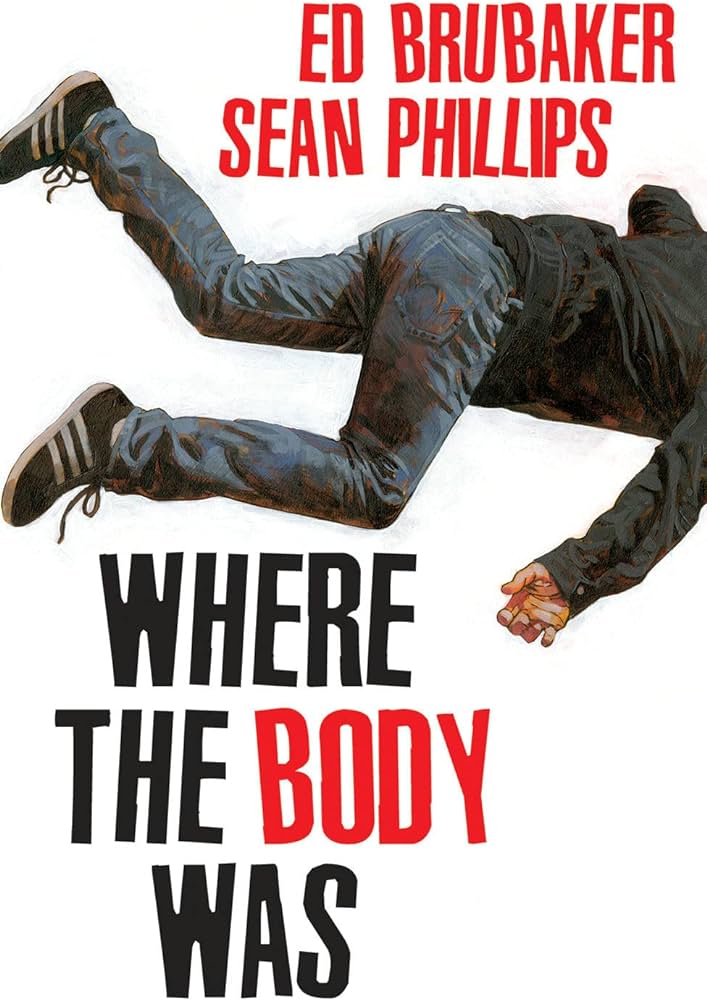
Brubaker/Phillip’s latest book is their funniest: a graphic mockumentary about how a dead body impacts a neighborhood.
The book begins with a map of Pelican Road, 1984. A Cul de Sac of just a few houses. But in the legend, notice #9. Spoiler: that’s where the body was found.

I grew up in a similar-looking cul-de-sac and had first-hand experience to attest that nothing ever happens here by design. A dead body? That’s something! Just being close to action gives these characters a strange new authority. They know where the body was. Listen to them! They must be important!
Maybe. Or what if the witness is a lying psychopath like Palmer Sneed, the “Man with a Badge.”
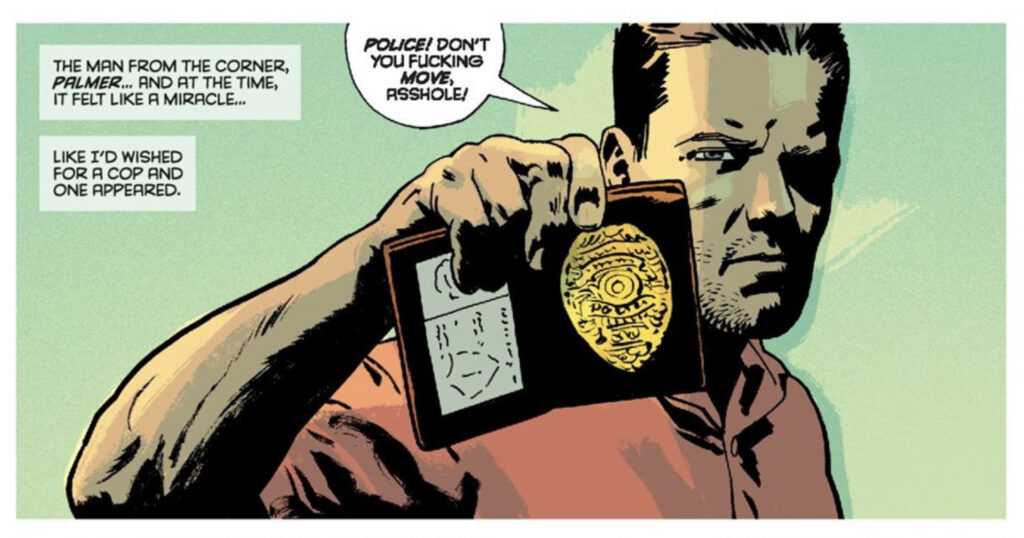
Palmer’s not a cop, but he acts like a cop. He resented his cop’s father and stole his badge from his casket to spit on him. Eventually, whenever he needed a confidence boost, he would flash the badge and get into or out of trouble. It helps him get laid. Of course, phony cops would get in the way of figuring out what happened to the body. But that’s just it. These guys come out when a body is found because dead bodies can be a conduit for their repressed vigilante tendencies.
Like Batman! There’s a diminutive parody of vigilantism and superheroes in The Roller Derby Girl, a.k.a. Lila Nguyen. In 1984, she dressed in a mask and cape, ran around the neighborhood, and pretended to be a superhero. Yes, that is weird, but not unheard of as something an American child might do since syndicated radio. So if a body is found, of course, the little kid playing superhero would need to fight crime and solve the case. Somebody has to do it!
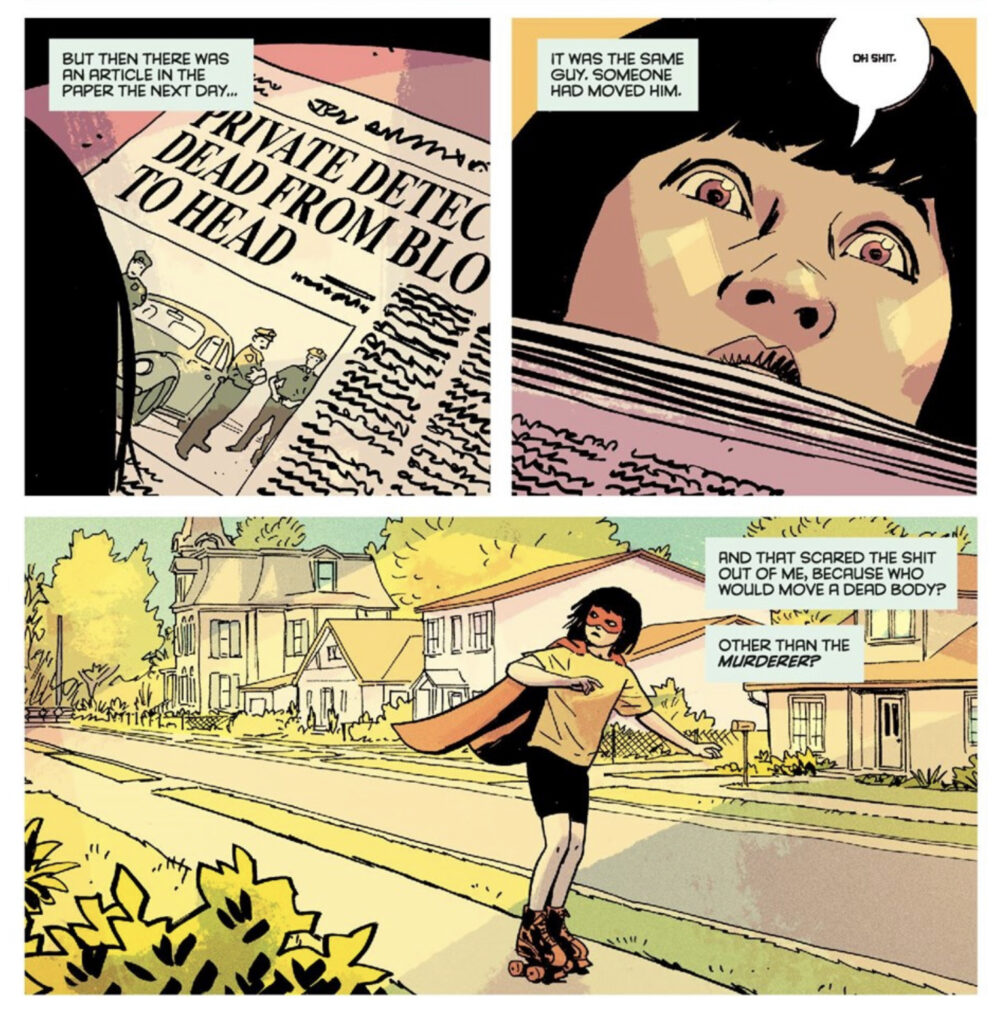
The real crime fighters are trying to solve the case by pinning it on Ranko, the Homeless Veteran.
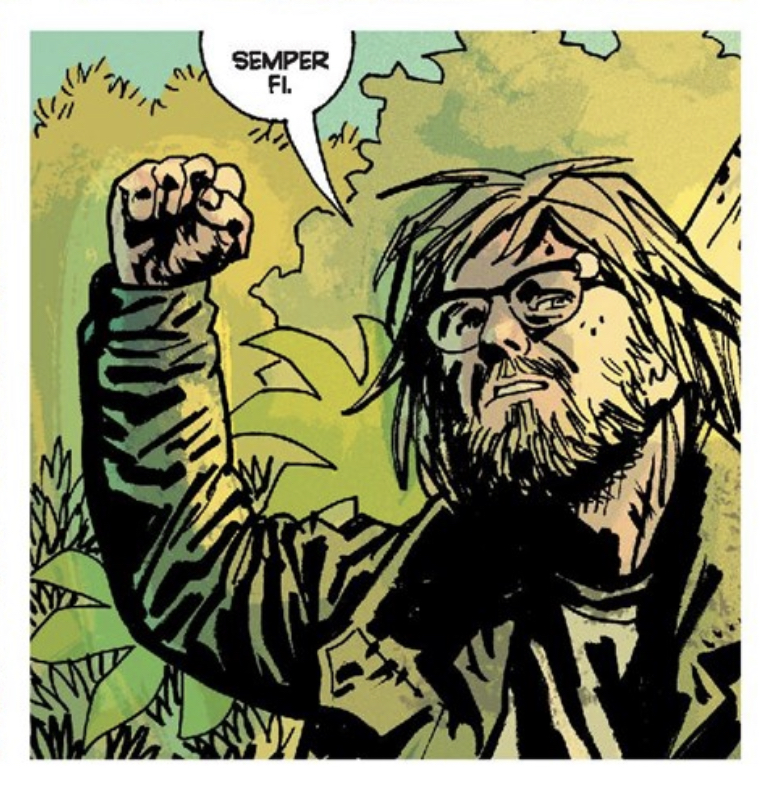
Because, come on, he looks like a criminal! He’s squatting on public property, and important people in town wish he were gone. He’s the perfect patsy.
I’ll leave you hanging there because this book was a blast! Fantastic art, dialogue, structure, colors, and vibe. Read it! Buy it at a comic shop, or if you’re broke, get it on Hoopla! Thanks, Image and Netgalley, for the Advanced Readers Copy.
Pile of the Week
This week’s pile has to be this sculpture of incredible birds sitting on top of books by Malia Jenson that I found in the Public Art Archive.
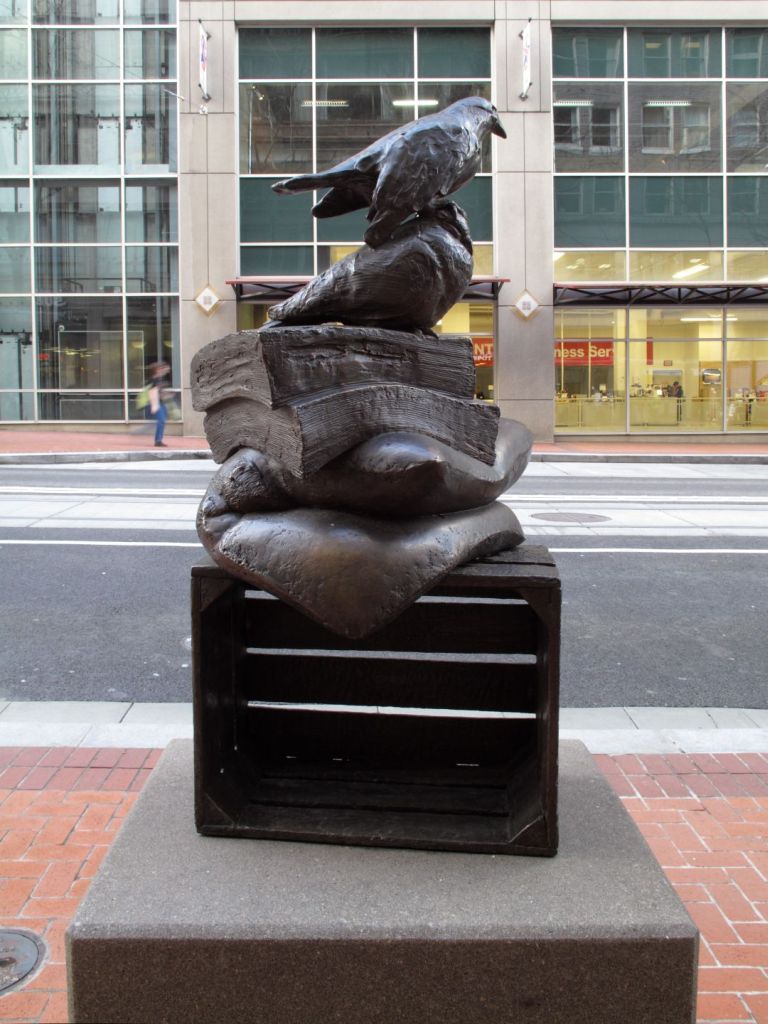

Leave a Reply